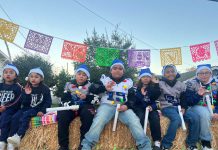Naturally
The Big Empty isn’t a place for everyone.
I worked with a Boston-born New Englander for a few years. He
was a genuine Yankee, as proud of his provincialism as his
Dartmouth education.
Naturally
The Big Empty isn’t a place for everyone.
I worked with a Boston-born New Englander for a few years. He was a genuine Yankee, as proud of his provincialism as his Dartmouth education.
If you’ve ever even glimpsed at a postcard of the region, you’re familiar with its landscape of rolling hills cloaked in dense stands of hardwood forest. New England is a place where people will drive through three states for the privilege of admiring a distant view.
Not long after this Yankee arrived in San Benito County, he determined to get the most from his California experience, to explore everything he could, whenever he could. He took a weekend drive to southern San Benito County. The next Monday, I asked him about his impressions.
He said he’d nearly fled back to the embracing comfort of town, a place with boundaries. The vast emptiness made him feel that, no matter where he turned, something was creeping up on him. There was just too much sky, too much horizon, too much empty space for one New Englander.
I count myself among those who love open spaces. Perhaps because most rooms, cars and chairs feel a little small for someone of my generous stature, I shun the closed-in feeling of the redwood forest in favor of the deck of a boat or the empty spaces of Central California.
A glimpse at a local map reveals the best of spots as the blank areas, places with few roads, landmarks and towns. One of the biggest empty spots marks a unique place that most of us never visit. That’s odd, because it’s a global tourist destination for a few people who know of its stark charm.
The place is Panoche Valley, reached by driving south through Hollister on Highway 25, then taking a left on Panoche Road at the Paicines General Store south of Bolado Park.
You’ll know you’ve reached Panoche Valley when you get there.
Its emptiness alone would make it special, but it reveals much more. In the summer, it is often airless with its heat. Bits of scorched stubble are insufficient to cover the bare earth. Even then, its rawboned beauty is striking. The wrack of old mines is scattered on a few hillsides. Sagging fences shrink and disappear on their way over distant hills.
When the rains arrive on the right schedule, as they threaten to this year with last week’s onset of the rainy season, the valley can be washed in the color of millions of wildflowers in spring. It doesn’t happen every year, but its occurrence can leave behind lifelong memories.
The valley’s real attraction as a tourist destination is linked to its unique location and habitat. The valley’s location perched in the mountains west of the Central Valley and its clipped grasslands make it a winter haven for a huge variety of birds. Many of these birds, like the Mountain Plover, are relatively rare and declining in numbers. Others, like Mountain Bluebird and Lewis’ Woodpecker, are regionally rare outside the valley. For some, the winter hawk show is the attraction, both for the quantity and variety of hawks and falcons. A trip to Panoche Valley in winter can result in a hawk fan’s grand slam – all four American falcons.
Like most things worth doing, finding what you’re looking for among Panoche’s birds can be difficult. The place is huge, roads are scattered and the birds are mobile.
It’s still a little early for the real bird show in Panoche Valley, and the flower display is months away. That will just give you time to set aside a full day for the expedition, because trying to get down and back in less time will probably only frustrate you.
When the time comes, if your quarry is birds, it makes sense to check in at the Panoche Inn. It’s easy to find – it’s the only place to buy a cold drink or a bite to eat in the entire valley, and it’s right off Panoche Road. The friendly owners of the roadhouse keep a logbook in which visitors to the region record their bird sightings, and a perusal of recent entries may launch a successful day. The trees and plantings around the inn also often hold their share of interesting birds.
On our last visit, in mid-October, a Sage Sparrow hopped around the parking lot. These usually shy birds are hard to get to know, because they typically lurk around under patches of sagebrush, according to field guide accounts. This bird obviously hadn’t read the field guides.
There’s more to the region than birds and flowers. Much of its rich history is left behind in clues. The area’s geological bounty was tapped in a host of mines. University researchers are studying a dinosaur fossil bed in the hills nearby.
For me, its biggest attraction remains its emptiness.
Mark Paxton lives in Hollister and works in Morgan Hill. Reach him via e-mail at pa*****@*****il.com.









